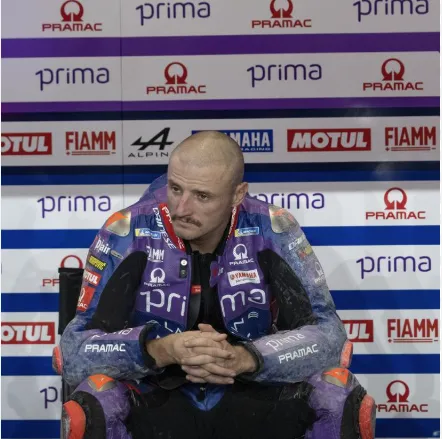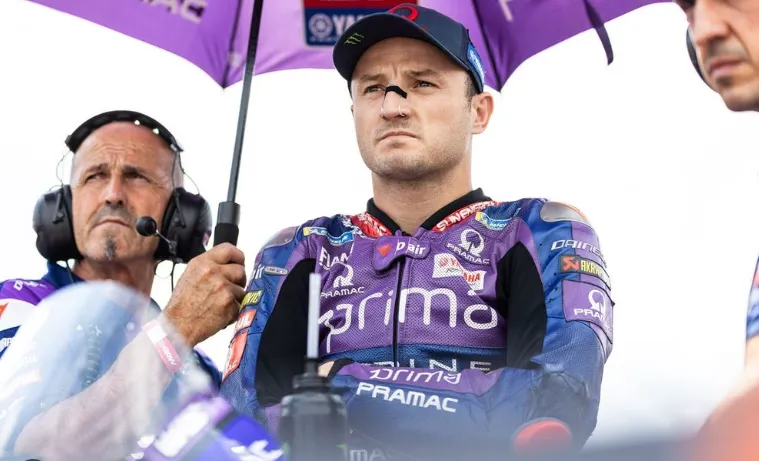

Jack Miller Talks About the Strange Sequence of Events Before His Crash in Qatar: What Really Happened to His Yamaha?
MotoGP fans were left in shock as Jack Miller suffered a bizarre crash at the Qatar Grand Prix, marking yet another low point in what’s been a turbulent season for the Australian rider. Riding the Yamaha YZR-M1, Miller experienced a series of unsettling vibrations and technical oddities before ultimately being forced to retire mid-race. With both Miller and teammate Augusto Fernandez failing to finish the fourth race of the season, serious questions are now being asked about Yamaha’s reliability, development path, and whether Miller is able to extract the best out of a bike many feel is lagging behind the competition.
This detailed breakdown explores what Miller himself said after the race, analyzes the strange sequence of events, and looks ahead to what could come next for the Australian veteran.
Jack Miller’s Strong Start Betrayed by Sudden Instability
Before his crash, Jack Miller’s pace was promising. The early laps showed signs that the Yamaha might finally be competitive—at least in Miller’s hands. He had momentum from a solid Tissot Sprint finish (19th place) and felt in sync with the bike as he chased the front group.
“It was the best I’d felt all weekend,” Miller explained. “The bike was working great—until it wasn’t.”
Miller noted that by Lap 9, something inexplicable started happening. He began to feel unsettling rear-end vibrations, the kind that made control nearly impossible.

“I switched the engine map, and coming into Turn 15—possibly my best lap—the bike suddenly started shaking violently from the rear. It was so bad my feet came off the pegs,” he said.
Despite this, Miller still managed a competitive time of 1:53.9, but then Jorge Martin overtook him. When Miller tried to hang on through Lap 10, another mysterious event occurred. Entering a left-hander in Lap 11, he completely lost front-end grip—despite having no earlier issues in that section.
The Technical Mystery: Was It the Yamaha or Something More?
Jack Miller’s crash wasn’t a simple loss of traction. His explanation reveals a deeper issue—something sudden and undetectable that defied Yamaha’s data.
“We can see it in the data,” Miller said. “Something changed from one lap to the next. Why? We don’t know yet.”
That statement alone raises eyebrows. Yamaha has long struggled with rear grip, corner exit stability, and high-speed consistency, especially compared to Ducati and KTM. But the way Miller describes the crash—violent, erratic shaking, sudden change in bike behavior—suggests a possible mechanical failure, software mapping issue, or tire malfunction.
While Miller mentioned that “the tires looked fine,” that doesn’t rule out momentary pressure drops, surface inconsistencies, or even hidden damage.
Yamaha’s Growing Crisis: More Than Just a One-Off Incident
What makes Miller’s crash even more troubling is that Augusto Fernandez also failed to finish. Fernandez went down on Lap 13, just two laps after Miller’s exit. That means both Yamaha factory riders were out by the final third of the race, a huge red flag for any top-tier MotoGP team.
The consistency of Yamaha’s issues—from vibrations to crashes and underperformance—is starting to point to systemic flaws in the 2025 YZR-M1 package.
Miller even admitted the entire week had been a struggle:
“Honestly, the way it ended kind of matched the way the week had gone.”
This kind of brutal honesty is rare in paddock interviews and might hint at internal tensions or dissatisfaction with Yamaha’s development direction.
Miller’s Crash in Context: How It Compares to Other Failures
Jack Miller is no stranger to mechanical gremlins. His aggressive riding style often pushes bikes to their limits, especially during braking and corner exit. But for a crash to occur without warning, after feeling stable, is rare even for him.
Compare this to other Yamaha crashes in recent years, especially with Fabio Quartararo, and a pattern begins to emerge: the bike is too sensitive to setup changes, engine mapping shifts, and corner load distribution.
Miller’s attempt to adjust the engine map just before the incident might have exposed or triggered an underlying instability in the rear suspension or electronics suite.
“I tried to hold onto the bike with my elbow. But when I leaned in more, it just got worse,” he said.
This detail—using his elbow to stabilize the bike—demonstrates Miller’s resilience and control. But even he couldn’t overcome what appeared to be an internal failure that data has yet to explain.
Yamaha’s Responsibility: Will They Investigate or Deflect?
As the dust settles, attention turns to Yamaha’s response. Will they dig into this mystery or brush it off as a rider error?
Miller clearly believes something went wrong technically:
“We need to understand what happened. Everything looked okay from the outside, but something definitely changed mid-race.”
The fact that this occurred in a crucial flyaway race like Qatar, where heat, grip, and high-speed sweeping corners test machinery to the limit, could help Yamaha diagnose the issue. But that’s only if they’re willing to look deeply and avoid placing blame solely on rider execution.
If Yamaha fails to uncover the root cause—or worse, pretends nothing happened—it could damage their credibility and jeopardize rider confidence.
Looking Ahead: Why Jack Miller Is Eyeing Redemption at Jerez
Despite the chaos in Qatar, Jack Miller remains optimistic about the next round in Jerez, Spain.
“I’m looking forward to Jerez—I think the bike will work well there,” he said.
This confidence isn’t just blind hope. Jerez’s tighter layout, cooler conditions, and lower top speeds may suit the Yamaha YZR-M1 better than Qatar’s long straights and sweeping corners. Jerez also favors technical riders like Miller who can manage throttle input and line selection with precision.
Miller may also be banking on a clean slate and better tire management, hoping Yamaha can rectify whatever glitch derailed his Qatar run.
The Spanish Grand Prix will be a major test—not just for Miller, but for Yamaha’s engineering team, who must prove they can deliver reliability, consistency, and data-driven improvements.

Fan Reactions: Sympathy, Frustration, and Hope
MotoGP fans have expressed a mix of sympathy and frustration over Jack Miller’s crash. Social media exploded with theories ranging from tire malfunctions to ECU glitches. Some fans praised Miller’s effort to stay upright and even try to rejoin the race—an effort that shows his deep commitment to fighting through adversity.
Others questioned Yamaha’s competence, asking why similar issues keep popping up across riders and seasons. For Miller fans, it’s heartbreaking to watch their rider face such bad luck—but many are standing by him, hopeful that Jerez will be a turning point.
Could This Be a Turning Point in Miller’s 2025 Season?
With three DNFs already looming large for Yamaha, Miller needs more than just luck. He needs the factory to deliver a stable, competitive bike, and soon. The 2025 season is shaping up to be a pressure cooker for both rider and manufacturer.
If Yamaha fails to resolve the rear-end instability and mapping issues, Miller might start exploring contractual options or hint at future team changes. But if they can fix the problem, Miller could become Yamaha’s strongest asset in rebuilding credibility.
Jerez could mark the start of a comeback story—or deepen the crisis.
Conclusion: Jack Miller Deserves Answers—and So Do MotoGP Fans
Jack Miller’s crash in Qatar wasn’t just another DNF. It was a high-speed mystery that exposed deeper flaws in Yamaha’s MotoGP machinery. From unexpected vibrations to mid-corner instability, the sequence of events leading up to his crash tells a story that demands investigation.
As fans and analysts await answers, one thing is clear: Miller is not giving up. He’s heading to Jerez with focus and determination, hoping to turn the page on one of the most bizarre race weekends of his career.
Whether Yamaha gives him the tools to succeed—or leaves him out to dry—remains to be seen.


















